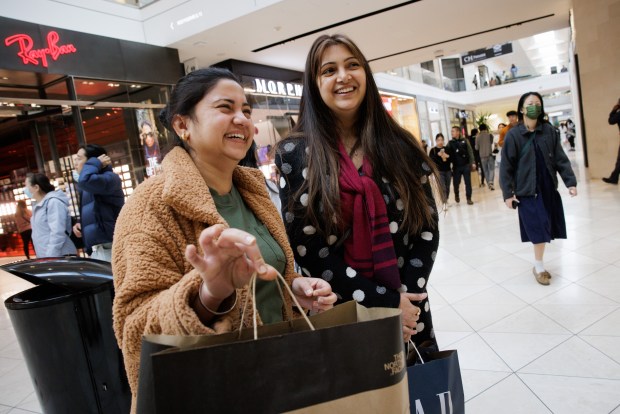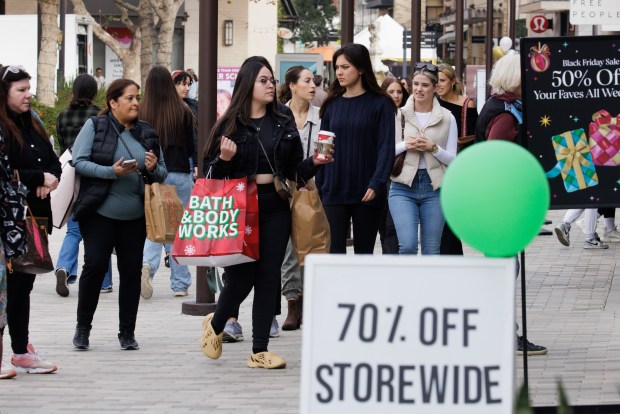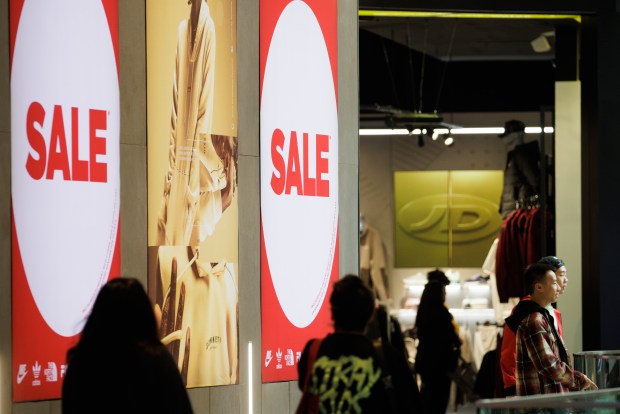The annual Black Friday shopping frenzy that for years filled Bay Area shops and malls may not be dead, but it appears to be struggling.
Already ailing from the rise of online shopping and having suffered a body blow from the COVID pandemic, the in-person Black Friday quest for great holiday deals looked subdued this year, with nary a wait for a mall-lot parking spot Friday morning. The crowds of days gone by teemed only in memories.
“There was literally no one in the stores when we got here,” said Kimberly Lozada, 53. The die-hard, decades-long Black Friday shopper had paused her traditional shopping spree in 2019 but hit San Jose’s Westfield Valley Fair mall hard Friday after bolting from her Berkeley home at 5:30 a.m. “Before, there used to be the lines out the door.”

Analysts studying the Black Friday picture across the U.S. said consumers were well positioned to rake in merchandise, with many people sitting on piles of pandemic-era savings, and softening consumer demand combining with an inventory glut to deliver bargains aplenty.
But economic troubles, including persistent inflation, rising interest rates and stock market declines, are weighing on Bay Area wallets. Steve Johnson, 70, went to Broadway Plaza in Walnut Creek on Friday morning, but only for a bite to eat, as the faltering stock market had halved his 401(k) retirement fund. “It sucks,” Johnson said.
Even folks determined to get out and loosen the purse strings in Black Friday’s shiny retail world kept a watchful eye on the economy. Carlos Ortiz, 48, grabbed a seat outside Sephora inside Valley Fair while his daughter, Gabby, browsed the store’s makeup aisles. Ortiz, of Santa Clara, said his family wanted to shop in-person for the rush of finding a good deal, but he was wary about what his daughter would ask to put on his charge card.
“I’m a little nervous about the bill, especially right now, because everything’s a little more expensive,” Ortiz said. “We’ll shop a little today, and then little by little we’ll add to our lists, so it’s not so heavy on the checkbook.”

Ortiz said it felt good to bring the family out for the occasion. “It’s hard to say ‘no’ to the kids,” he said. “We decided to spend here with the kids and have a little fun — as long as the bills are paid.”
This year’s economic conditions mean malls and shops hoping to entice shoppers have significant online competition. With a “price-sensitive consumer” seeking “the absolute best discounts,” the online marketplace is responding with discounts of up to 32% on computers and electronics, apparel and children’s toys, said Vivek Pandya, a lead analyst for Adobe Digital Insights, which analyzes e-commerce.
“These discounts are almost double the magnitude of last year,” Pandya said.
Local businesses are also counting on robust sales. “It’s about a third of our revenue for the year. If a retail store misses their holiday numbers, it’s very difficult to dig out of that hole,” said Nathan Walden, who owns two Nathan & Co. boutique gift shops in Oakland. His stores are filled with scarves, winter candles and colorful kitchen items.
Jyoti Shima and Tania Sehgal, best friends from Santa Clara, met up at Valley Fair, but without long shopping lists in these inflationary times. “Especially this year, everything is much higher,” said Shima, who had only purchased a North Face jacket she found for an extra 25% off in-store. “I really didn’t expect things to be that much.”

One thing was lower than they expected, however: the crowds of people they would have to weave through inside the mall. “Last year, it was like you needed to follow people in a row, it was so crazy,” Shima said. “I think weekends are more crowded than today.”
Still, Black Friday remains America’s favorite shopping day, with 115 million people across the U.S. planning to make purchases, and 67% of those saying they would visit stores, according to a National Retail Foundation survey.
Lozada of Berkeley said that as a single woman with no children, her current spending power is about the same as it was last year. “Black Friday is all about me buying for me,” she said, before conceding that she did buy her mom a Louis Vuitton makeup bag.
Bay Area shoppers on Black Friday ran into some supply chain woes, particularly for China-made goods. China’s ongoing COVID crackdown has slammed the production of Apple’s top-of-the-line iPhone 14 Pro, leading to a “major shortage,” Wedbush Securities analyst Dan Ives said in a note to investors Friday. No iPhone 14 Pros were available Friday at the Broadway Plaza Apple store in Walnut Creek.
“We believe iPhone 14 Pro shortages have gotten much worse over the last week with very low inventories across the board,” Ives said.
For those able to find what they want, many have sufficient cash reserves. Christopher Thornberg, an expert in economic forecasting at UC Riverside, pointed to the massive iceberg of savings accumulated during the pandemic and noted that according to the Federal Reserve, Americans have squirreled away $4.7 trillion into savings accounts and other financial instruments – up from about $1 trillion in 2019. “There’s $4.7 trillion burning a hole in our collective pockets, and it doesn’t care about rising interest rates,” he said.

But 70% of shoppers in one survey said they were changing their financial habits and reducing their spending compared to last year.
There are also recession clouds growing over the economy. A report by Wells Fargo dubbed this holiday shopping season as the “last hurrah” before an economic downturn.
“Households are spending, but they’re not really doing it from a sustainable source,” said Wells Fargo economist Shannon Seery. Savings accounts might be strong now, but they’re not being replenished as inflation eats into income, said Seery, who is forecasting a recession starting in mid-2023. One of the more ominous data points for Seery is the rising rate of credit card debt, which went up 15% this year, the largest increase in more than two decades, according to the Federal Reserve Bank of New York.
“What happens in the new year?” Seery asked. “You don’t have as much excess savings to rely on, maybe you maxed out the credit card, and I think you do start to see consumers tighten their belts a bit.”




Source: www.mercurynews.com
